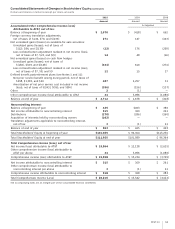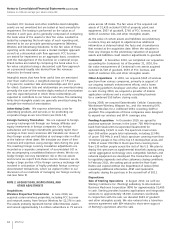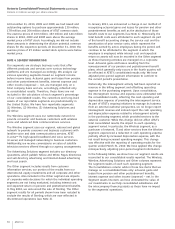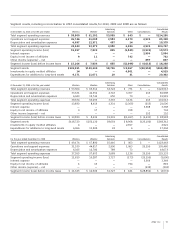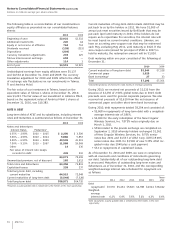AT&T Wireless 2010 Annual Report Download - page 72
Download and view the complete annual report
Please find page 72 of the 2010 AT&T Wireless annual report below. You can navigate through the pages in the report by either clicking on the pages listed below, or by using the keyword search tool below to find specific information within the annual report.
Notes to Consolidated Financial Statements (continued)
Dollars in millions except per share amounts
70 AT&T Inc.
At December 31, 2010, 2009 and 2008, we had issued and
outstanding options to purchase approximately 130 million,
178 million and 204 million shares of AT&T common stock.
The exercise prices of 100 million, 163 million and 144 million
shares in 2010, 2009 and 2008 were above the average
market price of AT&T stock. Accordingly, we did not include
these amounts in determining the dilutive potential common
shares for the respective periods. At December 31, 2010, the
exercise prices of 25 million vested stock options were below
market price.
NOTE 4. SEGMENT INFORMATION
Our segments are strategic business units that offer
different products and services over various technology
platforms and are managed accordingly. We analyze our
various operating segments based on segment income
before income taxes. Actuarial gains and losses from pension
and other postretirement benefits, interest expense and
other income (expense) – net, are managed only on a
total company basis and are, accordingly, reflected only
in consolidated results. Therefore, these items are not
included in the calculation of each segment’s percentage
of our consolidated results. The customers and long-lived
assets of our reportable segments are predominantly in
the United States. We have four reportable segments:
(1) Wireless, (2) Wireline, (3) Advertising Solutions and
(4) Other.
The Wireless segment uses our nationwide network to
provide consumer and business customers with wireless
voice and advanced data communications services.
The Wireline segment uses our regional, national and global
network to provide consumer and business customers with
landline voice and data communications services, AT&T
U-verseSM TV, high-speed broadband and voice services
(U-verse) and managed networking to business customers.
Additionally, we receive commissions on sales of satellite
television services offered through our agency arrangements.
The Advertising Solutions segment includes our directory
operations, which publish Yellow and White Pages directories
and sell directory advertising and Internet-based advertising
and local search.
The Other segment includes results from customer
information services, our portion of the results from our
international equity investments and all corporate and other
operations. Also included in the Other segment are impacts
of corporate-wide decisions for which the individual operating
segments are not being evaluated, including interest cost
and expected return on pension and postretirement benefits.
In May 2010, we announced the sale of Sterling. The Other
segment results for all periods shown have been restated to
exclude the results of Sterling, which are now reflected in
discontinued operations (see Note 2).
In January 2011, we announced a change in our method of
recognizing actuarial gains and losses for pension and other
postretirement benefits as well as the attribution of those
benefit costs to our segments (see Note 1). Historically, the
total benefit costs were attributed to each segment. As part
of the benefit accounting change, the service cost and the
amortization of prior service costs, which represent the
benefits earned by active employees during the period, will
continue to be attributed to the segment in which the
employee is employed, while interest cost and expected
return on assets will now be recorded in the Other segment
as those financing activities are managed on a corporate
level. Actuarial gains and losses resulting from the
remeasurement of our pension and postretirement benefit
plans, which generally only occurs in the fourth quarter, will
be reflected in AT&T’s consolidated results only. We have
adjusted prior-period segment information to conform to
the current period’s presentation.
Historically, the intersegment activity had been reported as
revenue in the billing segment and offsetting operating
expense in the purchasing segment. Upon consolidation,
the intersegment revenue and expense were eliminated with
the consolidated results, reflecting the cash operating and
depreciation expense of providing the intersegment service.
As part of AT&T’s ongoing initiatives to manage its business
from an external customer perspective, we no longer report
intersegment revenue and instead report the cash operating
and depreciation expense related to intersegment activity
in the purchasing segment, which provided services to the
external customer. While this change did not affect AT&T’s
total consolidated results, the impact to each operating
segment varied. In particular, the Wireless segment, as a
purchaser of network, IT and other services from the Wireline
segment, experienced a reduction in cash operating expense
partially offset by increased depreciation expense, with the
net result being increased operating margins. This change
was effective with the reporting of operating results for the
quarter ended March 31, 2010. We have applied this change
retrospectively, adjusting prior-period segment information.
In the following tables, we show how our segment results are
reconciled to our consolidated results reported. The Wireless,
Wireline, Advertising Solutions and Other columns represent
the segment results of each such operating segment.
The Consolidations column adds in those line items that we
manage on a consolidated basis only: actuarial gains and
losses from pension and other postretirement benefits,
interest expense and other income (expense) – net. In the
Segment assets line item, we have eliminated the value of
our investments in our fully consolidated subsidiaries and
the intercompany financing assets as these have no impact
to the segments’ operations.





